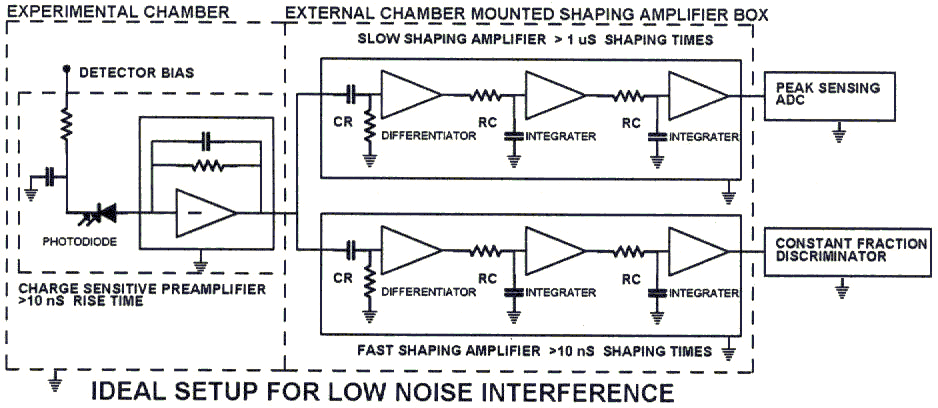
The Charge Sensitive Preamplifier is an inverting linear amplifier that has a small value series connected capacitor forming a feedback network. The charge sensitivity is the reciprocal of the feedback capacitance. Charge sensitive preamplifiers are commonly used in applications using solid state ion chambers similar to the one shown above. They are also used with many other types of signal sources such as gas filled ion chambers, proportional counters, photomultiplier and other types of vacuum electron photon sensitive tubes.
One of the problems with many detector types is that the terminal capacitance varies with bias voltage and temperature. When used to read a detector signal as in the application shown above, the output signal of a charge sensitive preamplifier is proportional to the charge collected in the detector and is very insensitive to variations in terminal capacitance. In some charge sensitive systems the useful dynamic range can greater than 1000/1 with noise in the 100's of KeV range. Voltage sensitive amplifiers are not very acceptable because the output signal varies inversely with changes in input terminal capacitance degrading system resolution.
Two characteristics of all charge sensitive preamplifiers must be noted. The charge preamplifier noise and risetime is proportional to the input terminal capacitance from all sources. Because of this, the detector design should minimize capacitance to the lowest practical level. Also, other sources of unnecessary capacitance like excessively long input cables should be eliminated.
Many preamplifier designs use a high value resistor in parallel with the feedback capacitor. The function of the feedback resistor is to discharge the feedback capacitor. The problem with the resistor is the thermal noise it contributes. Lower R, greater noise, higher R, less noise. Some designs do not use a resistor to discharge the feedback capacitor, eliminating the resistor noise. Photon sensitive solid state detectors are used to detect single photons with energies well below 1 KeV. GeLi detectors are used to detect photons with an energy tens of eV, so reset integrators are used. These are preamplifiers that discharge the feedback capacitor after many pulses are processed and the preamp dc level reaches some limit voltage. In many uses Si and gas filled detectors have much greater charge to collect, so the resistor noise is not as big a problem.
The output of a charge sensitive preamp is often fed to both a spectroscopy amp and a timing filter anp. Spec amps (slow shaping amps) are designed to be very linear, low noise, and have great gain stability. Timing filter amps (fast shaping amps) are designed for fast pulse response. They may be very linear, with great gain stability or they may have poor linearity and gain stability. The timing filter amplifier should not be substituted for a spectroscopy amplifier. If the spec amp time constant is greater than the preamp output rise time, the peak output pulse amplitude will be proportional to the charge collected, promoting good energy resolution. The time constant should also be chosen to give the best signal to noise ratio. If the spec amp time constant is less than preamp output rise time, the energy resolution will be degraded. The fast shaping amp output can be used to generate a trigger for time of flight (TOF) or other uses. The fast shaping time constant should be chosen for the greatest output signal to noise ratio divided by the rise time.
In a detector using a RC charge reset charge preamp followed by a shaping-amp, the preamp output rises until all the electrons and positive ions are collected on the anode and cathode. If the preamp rise time is much shorter than the charge collection time, the rise time observed at the preamp output is a measure of the charge collection time. This allows techniques like risetime discrimination to be used. After all the charge is collected, the preamp output begins to fall due to the resistor in parallel to the integrating feedback capacitor. If another detector event occurs before full output decay, the output pulse builds on the falling slope. This is not a problem in measuring the single event because the shaping amp only responds to the rising signal due to its differentiating input stage. However, at some event or charge rate the capacitor voltage will exceed the preamp output limit. This is the charge rate limit of the preamp, not to be confused with preamp dynamic range which is the single event charge limit.
What is the best RC value? The C is chosen based on the desired dynamic range and energy deposited. It is always good to have reasonable headroom. Also, keep in mind that the pulses are building on pulses which affects the charge rate limit. If the event rate is low, less headroom is needed, if it is high, more headroom is needed to make the charge rate limit acceptable. The resistor value must be chosen based on all the considerations discussed. A value that gives a >50 uS decay time is usually a good compromise. Longer decay times give less noise, but result in a reduced charge rate limit. In some low noise applications like Si X-ray detectors RC decay times up to 1000 uS are common.